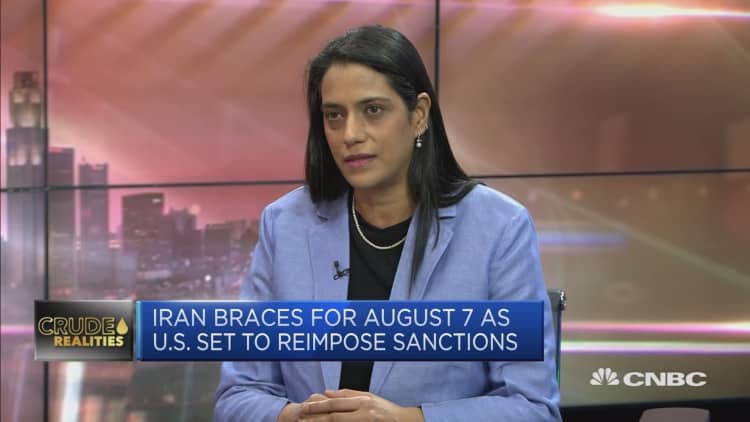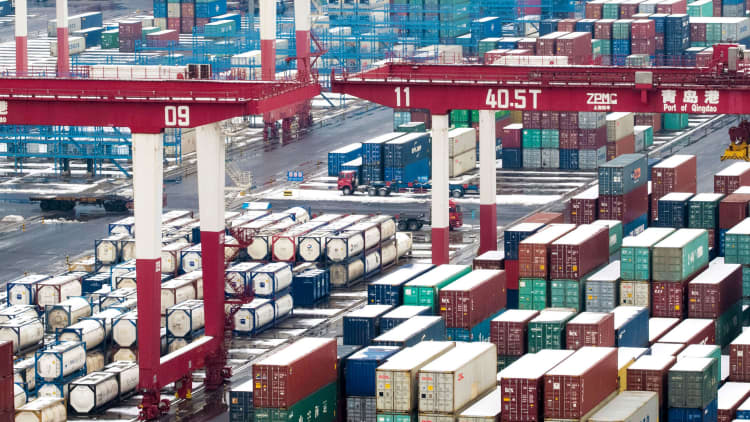India officially entered the ongoing global trade war in June when it announced retaliatory tariffs against Washington's steel and aluminum import duties. If implemented, the South Asian nation risks a targeted response from President Donald Trump's White House.
New Delhi's proposed tariff hikes on 29 U.S. products — including almonds, apples, walnuts and certain stainless steel products — are worth $241 million and were meant to go into effect on Aug. 4.
But Prime Minister Narendra Modi's government decided last week to delay the hikes, and may postpone tariffs until next month amid ongoing negotiations with U.S. officials, according to local news outlets.
If the two countries cannot reach a deal, New Delhi's tariffs will go ahead as planned — a move that could push Washington to respond with India-specific actions, similiar to what it's done with China. That, in turn, could spell trouble ahead for Modi as he campaigns for re-election next year, analysts say.
If the White House turns its attention to India's biggest exports to the U.S. — such as diamonds, seafood, auto parts and medicine — that could be risky for Modi and the Indian economy, said Amitendu Palit, a senior fellow specializing in trade and economic policy at the National University of Singapore.
Trump's team could also pressure on New Delhi to open up its agriculture and dairy industries, which are politically sensitive sectors in India's rural-based economy, Palit continued.
The world's largest democracy is known for high levies on agricultural imports as a means to safeguard the livelihood of its massive farmer population. Recent droughts and falling commodity prices have also triggered a hike in Indian import duties. In February, the government doubled levies on sugar to 100 percent, while chickpeas saw an increase to 40 percent.
The U.S. has previously urged India to keep agricultural tariffs low but since India's tit-for-tat measures mostly focus on agriculture, Washington now has a fresh opportunity to up the ante.
India boasts competitive advantages over the U.S. on services such as information technology, and its service exports are already under threat as the Trump administration tightens H-1B visa rules. Scores of Indian IT professionals are presently employed in the world's largest economy through the H-1B visa, and stricter procedures on issuance could limit the number of Indians working there.

"As the U.S. government tightens immigration and offshoring work, Indian authorities are likely to stay alert on the possibility that more sensitive and crucial sectors might fall under the radar next, including pharmaceuticals, for which the U.S. has already tightened vigilance and quality checks," said Radhika Rao, economist at Southeast Asia's largest bank DBS.
Why India retaliated
New Delhi's decision to fight back may have been surprising to some since it isn't a major exporter of steel and aluminum heading stateside. In 2017, the U.S. accounted for about 2 percent of India's steel exports, according to data from IHS Global Trade Atlas. And only 2 percent of Indian aluminum exports go the the U.S., AFP reported.
But, given the longstanding history of bilateral trade frictions, India's position isn't completely out of the blue.
New Delhi and Washington have both brought cases against each other before the World Trade Organization dispute settlement body several times in recent years. In 2003, India complained that American textiles and clothing were being protected from import competition. And in 2013, the U.S. opposed India's national solar program, claiming it discriminated in favor of domestic firms.
"Trade issues have been an irritant in (U.S.-India) ties for years, so this is not entirely new," said Dhruva Jaishankar, a fellow in foreign policy at Brookings India, referring to India's response.
Modi is believed to be following in the footsteps of China, the European Union and Canada, which have all announced countermeasures against Washington.

India's retaliation isn't unique as "all national governments are likely to adopt a defensive strategy as trade relations come under pressure," said Rao.
Beijing responded to recent U.S. tariffs with 25 percent levies on $34 billion worth of U.S. goods and, if Washington responds with fresh hikes, the world's second-largest economy may impose duties ranging from 5 percent to 25 percent on $60 billion of American products. The European bloc, meanwhile, currently has instituted new tariffs on over $3 billion worth of U.S. items, including bourbon, peanut butter and orange juice.
American officials are said to have been talking with their Chinese counterparts, but a deal has yet to materialize. The U.S. and E.U., meanwhile, have agreed to negotiate tariff reductions.
What may be next
Unlike the situation between Washington and Beijing, the trade spat between the U.S. and India is not expected to intensify further. The fact that Modi decided to defer tariffs indicates expectations for a mutually acceptable solution, experts say.
"India has opted to take a tough negotiating position in bilateral disputes with Washington, but has also left sufficient wiggle room for both sides to reach an accommodation," said Jaishankar.
"The value of goods on which India has placed tariffs is reciprocal, so it is quite possible that this will not escalate much further," he added.
Adding to the optimism, the U.S. Department of Commerce last week granted New Delhi a special status that gives the emerging market an automatic waiver for exports of certain military and dual-use technologies. Known as Strategic Trade Authorization-1 (STA-1), that status is typically reserved for treaty allies and underlines the importance of U.S.-India security ties.
Washington doesn't look at India the same way it views China, according to Palit, who pointed to the countries' convergence on many issues. Respect for the overall relationship will likely push both sides to find an agreement on tariffs, he said.
WATCH: A (brief) history of the world's trade wars


